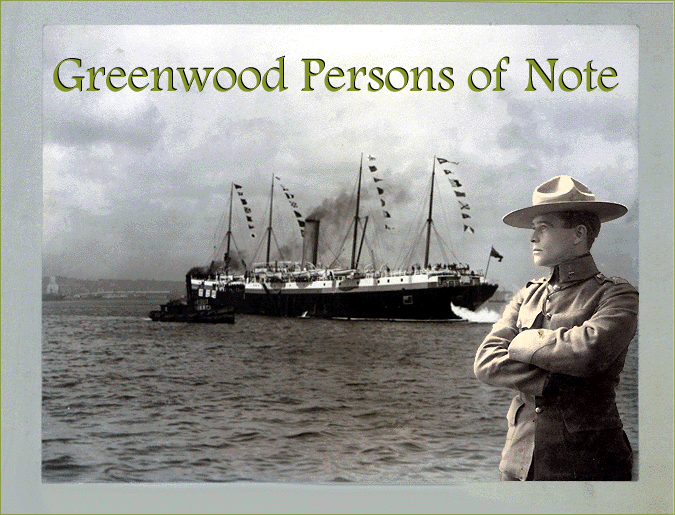


BY: BG EDITOR
Jan 25, 2020 — GREENWOOD, BC (BG)
The Leckie Brothers
In the summer of 2017 we published three consecutive articles (1, 2 & 3) in Beautiful Greenwood on local war heroes, the Leckie Brothers — two prominent Greenwood residents who distinguished themselves in Canadian military service. Over the course of the series we presented much interesting information about the brothers, gleaned from local historical newspapers and other military archives.
In July 2019 we were very pleased to receive a letter from Mrs. Catherine Wollaston of Chelmsford, Essex, England. While researching her family history she came across our articles, which helped to fill-in some of the blanks in her archives. Likewise she shared her findings with us, and they help to provide a more complete history of the Leckie Brothers.
The brother most famously known for his military service was Capt. R. G. Edwards Leckie, known to the people of Greenwood as Major Leckie. His brother Jack also served as an officer in South Africa. The Wollaston's connection to the Leckies was through Jack Leckie, who had recruited Catherine's husband's (Richard Wollaston's) grandfather, Frederic Wollaston, to the Second Canadian Mounted Rifles at Fort Steele, in December 1901. This took place after the return of the Strathcona Horse from South Africa.
Catherine writes:
"Your article mentions that you have found no record of Leckie returning to South Africa after the return of the Strathcona Horse but you may be interested to know that he did indeed return. The Second Canadian Mounted Rifles travelled to South Africa in January 1902 and saw service there until the war ended in June 1902. Both Leckie brothers commanded squadrons and saw action at the Battle of Harts River. (Daily Colonist 5 April 1902)."
Catherine provide links to several very interesting summaries on the Leckies history, including one on the history of the 2nd Regiment, Canadian Mounted Rifles, and another fascinating piece about Colonel Jack Leckie, D.S.O. The latter article offers this description of brother Jack:
"Colonel "Jack" was dashing, impulsive, with the stocky build which indicated great reserves of physical strength, and the temperament of the man of action ready for any adventure. And of adventures he had more than the considerable share which generally is met with by members of his calling. He passed along the most beaten paths of land, sea and air, and ventured on others, of which the majority of humankind know nothing outside of story books.
(Urquhart, History of the 16th Battalion CEF, 1932, 97)"
We also find this tribute by a poet for the battalion trench journal, the Brazier:
Come call your boys together,
Major Jack,
They will follow to the death,
Where you lead them, when you need them,
Major Jack
Major Jack,
They will follow to the death,
Where you lead them, when you need them,
Major Jack
The Soldier 'O Fortune article links to another article, about Jack's brother, R.G.E. Leckie.
Catherine Wollaston also shared some of the interesting history of her husband's grandfather, Fred (Frederic) Wollaston, who had his own connections in the Boundary, both in Grand Forks and Greenwood.
"Fred stayed on in South Africa after the war ended, working as a mining engineer in the West Rand gold fields until 1912 when he returned to Victoria, only to volunteer to serve in the First World War, where he was severely injured on the Western Front.
Fred was a Provincial Land Surveyor and engineer who carried business in Grand Forks from 1896 to 1901, initially with Charles de Blois Green who practised in Fairview, but from 1898 on his own account. Green was a fascinating character of whom you may well be aware. In case not, you may be interested in his obituary, attached, from which you will also note his expertise and reputation as an ornithologist. (He had a ranch at Twin Lakes). Fred carried our several surveys in Greenwood and was sometimes there for weeks at a time. He remained closely associated with Greenwood through his brother, Francis Henry Wollaston ('Frank') who, with Constantine Arundel, discovered the Nickel Plate Gold Mine at Hedley (and whose own life story is quite fascinating).
Fred was a very active citizen - the first City Clerk of Grand Forks and subsequently Treasurer of the Board of Trade, Clerk to the Returning Officer, City Engineer, Licensing Commissioner and frequent Committee member for such purposes as organising a fire service. He was also President and founder of the Grand Forks Lawn Tennis Club and the Baseball Club and officiated at race meetings as well as participating in various social events, always ready to give a song. Later he lobbied on various issues relating to the city's mining and railway ambitions and was active in the organisation of the Liberals in Grand Forks.
Given Fred's profession and his interests, I think it reasonable to suspect that he may have enjoyed an acquaintance, even a friendship with Jack Leckie. I wonder if he might have been one of the members of the Greenwood Club, mentioned in your article.
When I first started my researches I was at a loss to understand why Fred had suddenly dropped everything and gone off to fight the Boers, to the apparent consternation of his friends. Since then I have become more aware of the intense patriotism towards the Mother Country and the Empire which gripped Canadians of British descent at the time. I believe that Fred's association with Jack Leckie might well have fuelled his enthusiasm to join up, hence my interest in him."
The Wollaston's travelled to the Boundary last fall on a research holiday, visiting Greenwood, Grand Forks and Hedley. We suggested they visit the Greenwood Museum, which they were very pleased to do.
We'll continue this 'Persons of Note' feature on the Leckie Brothers next week, sharing more of the fascinating history of two of Greenwood's finest men.


